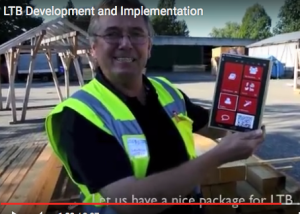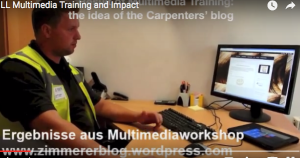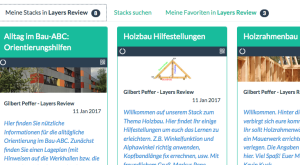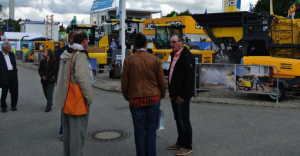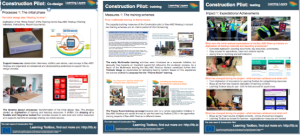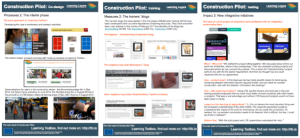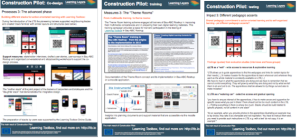The Legacy of “Learning Layers” Construction Pilot – Part One: The project experience in a nutshell
During the last four years (2012-2016) I have mainly been writing on our ‘ongoing EU-project Learning Layers’. And during the last few weeks (since November 2016) I have been writing on the final reporting of the project. My latest series of posts was about the Final Review Meeting in January 2017 in Verden. Someone might think that I have said everything that there is to be said about the completed project. Yet, I do not share that view. As a matter of fact our reviewers challenges us to do some more homework. They asked us to prepare more compressed summaries (on the work packages) on what we tried to do, what we achieved and what we learned during the project. And they asked us to link the web documents on our ‘final deliverable’ website results.learning-layers.eu. Also, the reviewers asked us to present some self-critical reflections on things that we could have done otherwise. (In my latest post I started thinking loud, what kind of answers we can give.)
Now that I have done my part of this extra homework I find it useful to present this ‘nutshell picture’ as a blog under the heading ‘Legacy of “Learning Layers” Construction Pilot”. I think that the following paragraphs give a genuine picture of what we tried to do and what we achieved – and what we learned in the Construction Pilot of the Learning Layers project.
Co-design approach and process dynamics
In the construction pilot the leading initiative in co-design work was started with the design idea of digitising training and learning materials in the training centre Bau-ABC (“Sharing Turbine”). This initiative was perceived as a key step to digitise vocational education, training and learning processes across the apprentice training in construction sector. In several iterations this design idea was transformed into the shaping of an integrative toolset (mobile app) that provides access to web resources, project documents and work- and learning-related contacts (“Learning Toolbox”). This process was shaped as a strongly user-oriented R&D dialogue that involved construction sector trainers (from Bau-ABC), technical partners (RayCom, CIMNE, Pontydysgu) and accompanying researchers (ITB).
References: The dynamics of the process and the contributions of different parties have been reported in the Methodology document “Accompanying Research and Participative Design in the Pilot Activities with the Learning Toolbox (LTB)”.
Capacity-building and training model
In the construction pilot the initial interviews brought into picture a scattered landscape of separate digital tools and apps that were not considered appropriate as support for work-related learning. Alongside co-design workshops the project organised a generic Multimedia Training Scheme to support the Bau-ABC trainers’ capability to create their trade-specific digital training and learning environments. The key results of this phase were the trainers’ blogs (Zimmererblog, Maurerblog, Tiefbaublog, Brunnenbauerblog) that they used as their trade-specific repositories for digital training materials. Later on, a broader and more construction-focused training model – the Theme Room Training – was initiated by the trainers to support the use of digital media and web resources (and of Learning Toolbox) in Bau-ABC. The Theme Room Training was implemented in 2015 by the project team and it engaged all training staff of Bau-ABC.
References: The development of the capacity-building approach and training activities has been reported in the Methodology document “Training Interventions as Capacity-Building for Digital Transformation in Vocational Education and Training”. The impact has been presented in the Impact Case “Multimedia Training for and with Bau-ABC Trainers”.
A detailed report on the planning and implementation of the Theme Room Training is provided in the Master Thesis of Jaanika Hirv for the Tallinn University:
Hirv, J. (2016). Digital Transformation: Learning Practices and Organisational Change in a Regional VET Centre. Master’s thesis, TLU.
A detailed documentation on the development of the training schemes and a digital archive of the training materials is provided in the moodle-application ITB-Moodle. The “Theme Room Training 2015”.
Piloting with Learning Toolbox and peer tutoring
As a result of the co-design and tool development work in the construction pilot the Learning Toolbox was introduced in Bau-ABC to be used in their apprentice training in selected trades. For this purpose the responsible trainers created their own stacks for the respective training projects. When the apprentices moved to training periods in neighbouring trades, the trainers created further stacks for these projects. The following trades were covered: well-building (Brunnenbau), metalworking (Metalltechnik), pipeline-building (Rohrleitungsbau), carpentry (Zimmerer), bricklaying and masonry (Maurerwerk). Trainers of carpenters and bricklayers decided to create stacks for a joint project the draws attention to a working interface of the two trades. In addition, the shop steward for health and safety (Sicherheitsbeauftragte) started to develop a specific stack for training in this field.
References: The measures to introduce the Learning Toolbox into apprentice training in Bau-ABC and the immediate impact have been reported in the Impact Case “Use of Learning Toolbox by Bau-ABC Trainers and Apprentices”.
Insights into pedagogic approaches of trainers and learning behaviour of apprentices are provided in the Scenario document “Learning Toolbox (LTB) as Support for Action-Oriented Learning in Vocational Education and Training (VET)”.
Outreach activities and engagement of further users
Alongside the co-design and pilot testing activities the construction pilot has organised outreach activities to engage further users of the Learning Toolbox. Most of these contacts have led to very focused trade- and company-specific negotiations. A generic use case has been documented on the basis of Thomas Isselhard’s work as a construction site manager in Verden. Based on a workshop for craft trade companies (and on the presentation of Thomas Isselhard) the construction pilot outlined a scenario for craft trade companies and their collaboration with planners, authorities and parallel trades.
References: The model of using Learning Toolbox to coordinate the work of planners and different craft trade teams has been presented in the Scenarios and Models document “Learning Toolbox as Support for Organisational Learning and Cooperation at a Construction Site in Verden – Instances of Change”.
The presentation of Thomas Isselhard’s has been recorded on two videos:
Video 1: LTB at Use on Construction Site in Verden – Thomas Isselhard’s Presentation
Video 2: LTB at Use by Companies – Discussion after Thomas Isselhard’s Presentation
Lessons learned
Concerning the strategic choices regarding co-design processes (to develop new tools to be tested and deployed during the project) vs. diffusion processes (to select existing mature tools to be piloted as a alternative or complementary action) the construction pilot team has concluded:
- The needs and expectations of the application partners could only have been met via participative co-design processes. Likewise, the capacity-building measures alongside the co-design were crucial to equip construction sector users with necessary digital competences.
- The co-design approach (to develop a flexible and integrative toolset “Learning Toolbox”) would have enabled earlier piloting with existing multimedia tools (to be integrated to the Learning Toolbox). Such complementary piloting in Bau-ABC would have been useful in the intermediate period between the two training schemes and as a preparation for the introduction of the Learning Toolbox.
- Complementary piloting with existing tools (alongside co-design of Learning Toolbox) could have been used as bridging measures to involve interested construction companies in pilot activities. Now the engagement of companies started only when the Learning Toolbox was ready for piloting.
– – –
I think this is enough of the general picture of Construction pilot and of the legacy of the intensive project years 2012-2016. However, in this context I have had a special chance to review the cooperation of our project team with our application partner organisation Bau-ABC Rostrup and the impact of our activities. I will focus on this in my next post.
More blogs to come …
